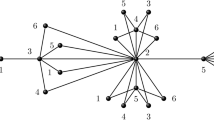Abstract
Two graphs are said to be chromatically equivalent if they have the same chromatic polynomial. In this paper we give the means to construct infinitely many pairs of chromatically equivalent graphs where one graph in the pair is clique-separable, that is, can be obtained by identifying an r-clique in some graph H 1 with an r-clique in some graph H 2, and the other graph is non-clique-separable. There are known methods for finding pairs of chromatically equivalent graphs where both graphs are clique-separable or both graphs are non-clique-separable. Although examples of pairs of chromatically equivalent graphs where only one of the graphs is clique-separable are known, a method for the construction of infinitely many such pairs was not known. Our method constructs such pairs of graphs with odd order n ≥ 9.
Similar content being viewed by others
References
Bari, R.: Recent results on chromatically equivalent graphs. In: Annals of the New York Academy of Sciences: Second Internal Conference on Combinatorial Mathematics, vol. 319, pp. 36–46 (1979)
Bari, R.A.: Chromatically equivalent graphs. In: Dold, A., Eckmann, B. (eds.) Graphs Combin. Lecture Notes in Mathematics, vol. 406, pp. 186–200. Springer, Berlin (1974)
Chao, C., Whitehead, E.G. Jr.: On chromatic equivalence of graphs. In: Dold, A., Eckmann, B. (eds.) Theory and Applications of Graphs: Proceedings, Michigan May 11–15, 1976. Lecture Notes in Mathematics, vol. 642, pp. 121–131. Springer, Berlin (1978)
Chao C., Whitehead E.G. Jr.: Chromatically unique graphs. Discrete Math. 27, 171–177 (1979)
Dong F.M., Koh K.M., Teo K.L.: Chromatic Polynomials and Chromaticity of Graphs. World Scientific, New Jersey (2005)
Morgan, K., Farr, G.: Chromatic factors (submitted)
Morgan, K., Farr, G.: Certificates of factorisation for a class of triangle-free graphs. Electron. J. Combin., 16: Research Paper 74 (2009)
Morgan, K., Farr, G.: Certificates of factorisation for chromatic polynomials. Electron. J. Combin., 16: Research Paper 75, (2009)
Oxley J.G.: Matroid Theory. Oxford University Press, Oxford (1992)
Read R.: Connectivity and chromatic uniqueness. Ars Combin. 23, 209–218 (1987)
Read, R.C., Tutte, W.T.: Chromatic polynomials. In: Beineke, L.W., Wilson, R.J. (eds.) Selected Topics in Graph Theory, vol. 3, pp. 15–42. Academic Press, London (1988)
Whitney H.: 2-Isomorphic graphs. Am. J. Math. 55, 245–254 (1933)
Xu S., Li N.Z.: The chromaticity of wheels. Discrete Math. 51, 207–212 (1984)
Author information
Authors and Affiliations
Corresponding author
Rights and permissions
About this article
Cite this article
Morgan, K. Pairs of Chromatically Equivalent Graphs. Graphs and Combinatorics 27, 547–556 (2011). https://doi.org/10.1007/s00373-010-0984-z
Received:
Revised:
Published:
Issue Date:
DOI: https://doi.org/10.1007/s00373-010-0984-z




